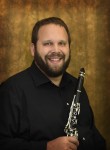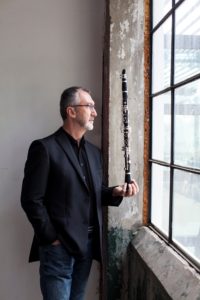Clarinet – Solo/Duo
Soprano Clarinet
Clarinet Sonata(11/26/21) for clarinet and piano – 12’30. Much of the thematic material throughout this piece is derived from the opening Adagio of the first movement. The opening two-measure fanfare by solo clarinet is answered by more lyric and peaceful descending figures. Following that introduction, the movement relies on a simple ternary form. The slow, Largo movement begins with a piano figure borrowed from measures 5-6 of the first movement’s Adagio. The clarinet changes the descending figures from there into ascending figures followed by now familiar dotted rhythms. The piano introduces a new theme accompanied by wide leaps from the clarinet. A march-like theme from the clarinet incorporates those wide leaps. The finale begins with four measures from the opening Adagio played in retrograde. The next four measures are extensions of measures 3-4 of the Adagio. These eight measures are the theme of the movement. Variations begin in measure 17, in sixteen, eight or four measure groupings. A brief clarinet cadenza leads to the final full variation of the theme and a short codetta. MIDI recording.
Contrasts – Sonata for Clarinet and Piano (2011) – 9’40”. “Contrasts” is light and cheerful with sixteenth-note activity from the piano against short, lyric phrases from the clarinet. “Interlude” is much darker and chromatic. The clarinet has a long solo in the chalumeau register over ostinato chords. “Dialogue” features the interplay of several ideas passed between the clarinet and each hand of the piano part. It has a driving rhythm and a bold character. MIDI recording.
Known Lights (2009) for clarinet and piano was premiered by Andrew Sprung, clarinet, and Brad Blackham, piano, on March 24, 2018, in the Conrad Recital Hall at The Hillsdale College in Hillsdale, Michigan. 
Known Lights, Clarinet Sonata No. 2 (2009) for Clarinet and piano – 14’40”. As the title suggests, this work is inspired by common sights, views from the everyday world that create an emotional response. In “Turbulent Skies” I was responding to a cloudy, windy, blustery day. It’s the kind of day that threatens rain but never actually creates it. “Starshine Dances” was inspired by the twinkling of the stars. The light is faint and shimmering, in some ways insubstantial and fleeting. In “Before Dawn” the light is calm and serene, but life is stirring in anticipation of the new day. Because the light is faint, there is a certain mystery to it. In “Sunlit Streams and Rapids,” however, the light is bright. The water sparkles with sudden energy, only to be replaced by calmer waters that distort the light and delight the eyes. “Turbulent Skies” is in a modified ternary form. The A section is a set of variations based on the imitation between clarinet and piano created in the opening measures. The B section is a clarinet solo over a chordal accompaniment. “Starshine Dances” is a seven-part rondo and coda – ABACAB’A’ with the coda based on the A sections. The frequent meter changes are meant as a reminder of the fleeting quality of the light, and the use of silences in the coda is meant to be Haydn-esque.
Live performance. The piece was premiered by Andrew Sprung, clarinet, and Brad Blackham, piano, on March 24, 2018, in the Conrad Recital Hall at The Hillsdale College in Hillsdale, Michigan.
Numinous Ignotus (1987) Sonata for clarinet and piano – 13’00”. The sonata is in three movements. The first begins slowly and feels very open. The middle section is more rhythmic and dramatic. The second movement is lyric and calm, but it develops intensity as it progresses. The finale is playful, with a cadenza that requires the use of multiphonics and borders on the comic.

Nathan Williams, clarinet
Live performance. The piece premiered March 13, 1987, at Salem College, Winston-Salem, by Nathan Williams, clarinet, and Nancy Wurtele, piano.
Bass Clarinet
Four Characters in Search of a Sonata (9/12/13) for bass clarinet – 11’00”. The four characters or movements in this work are really etudes rather than traditional sonata movements. “Self-Doubter” explores two aspects of the bass clarinet: its altissimo range and its ability to produce multiphonics. Every time a melodic statement is made, multiphonics express doubt about its validity “Obsessive” is an etude exploring arpeggios and scales. “Confident Soldier” explores wide leaps and breath control on the instrument. It is set as a march, but the sections are quite irregular in length and most end “on the wrong foot.” “Laid-Back” is about performing rhythms in a jazzy, laid-back manner. It also explores glissandos briefly in its middle section. The idea is that the rhythmic sense should be very relaxed, as if the performer did not have a care in the world. MIDI Recording.